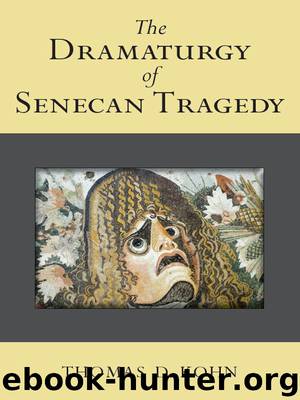The Dramaturgy of Senecan Tragedy by Kohn Thomas;

Author:Kohn, Thomas; [Kohn, Thomas;]
Language: eng
Format: azw3, epub
Publisher: University of Michigan Press
Published: 0101-01-01T00:00:00+00:00
The center doors in this play represent not the royal residence as in most Senecan drama, but a temple.18 One wing leads to the palace, which could be seen as equivalent to the forum, that is, a public place where public events happen, while Hercules and Theseus use the other on their approach from the Underworld, the ultimate “foreign part.”
Dramaturgical Issues
ACT 1 (1–124)
Action unit: Juno delivers the prologue, informing the audience of her intent to drive Hercules mad.
At line 1, Juno enters and begins her monologue. She identifies herself as Jupiter's sister (soror tonantis, 1), but, as is typical for Senecan tragedy, she gives no motivation for her entrance. She is a goddess, and so it would be appropriate for her to appear ex machina, hovering in the air above the stage. She states unequivocally, however, that all the mortal harlots with whom Jupiter has slept and produced sons have usurped her accustomed place on Mt. Olympus (ac templa summi vidua deservi aetheris locumque caelo pulsa paelicibus dedi, 3–4). Thus, Juno has been evicted from her usual spot, and stands on the stage as any other mortal character would.19 There is also no indication of which entrance she uses, but the temple is a fitting place for her to spend her exile. While discussing the various lovers of Jupiter and their children who have taken over the heavens as constellations, she uses demonstrative pronouns to point them out (hinc…hinc…illinc…hinc…hinc, 6, 8, 10, 12, 14). It is possible that the constellations are actually painted on the scaenae frons, but more likely that she merely gesticulates toward the sky as she talks. Further, when Juno talks of the river Styx (en retegit Styga, 54), as well as the horrors of the Underworld (hic tibi ostendam inferos, 91) that she will show to Hercules here on earth, such sights should not be thought to be realistically portrayed. Instead, such statements speak to the theme of the play: madness. Just as in Shakespeare's Macbeth, the characters describe things, and the audience is not sure whether they are real or not. As early as the prologue, then, Seneca establishes that the spectators cannot trust their eyes, and that the characters are not necessarily in touch with reality. At line 118, Juno says she will remain (stabo) and supervise the Furies as they persecute Hercules, another indication that things are not what they seem. The audience is to accept the presence of Juno as it watches the rest of the play, even though she is not physically present. In fact, following line 124, Juno exits, going into the temple through the center doors. She does not give any motivation, nor comment on her departure in any way, aiding the illusion that she is still present in spirit; that is, if she does not discuss her leaving, it is almost as if she is still here.
Download
The Dramaturgy of Senecan Tragedy by Kohn Thomas;.epub
This site does not store any files on its server. We only index and link to content provided by other sites. Please contact the content providers to delete copyright contents if any and email us, we'll remove relevant links or contents immediately.
Aircraft Design of WWII: A Sketchbook by Lockheed Aircraft Corporation(32134)
The Great Music City by Andrea Baker(30778)
Call Me by Your Name by André Aciman(19894)
The Art of Boudoir Photography: How to Create Stunning Photographs of Women by Christa Meola(18400)
The Secret History by Donna Tartt(18149)
Shoot Sexy by Ryan Armbrust(17554)
Plagued by Fire by Paul Hendrickson(17105)
Portrait Mastery in Black & White: Learn the Signature Style of a Legendary Photographer by Tim Kelly(16867)
Adobe Camera Raw For Digital Photographers Only by Rob Sheppard(16794)
Photographically Speaking: A Deeper Look at Creating Stronger Images (Eva Spring's Library) by David duChemin(16494)
Ready Player One by Cline Ernest(13975)
Pimp by Iceberg Slim(13771)
Bombshells: Glamour Girls of a Lifetime by Sullivan Steve(13680)
The Goal (Off-Campus #4) by Elle Kennedy(13192)
Art Nude Photography Explained: How to Photograph and Understand Great Art Nude Images by Simon Walden(12848)
Kathy Andrews Collection by Kathy Andrews(11320)
The Priory of the Orange Tree by Samantha Shannon(8601)
Thirteen Reasons Why by Jay Asher(8447)
The remains of the day by Kazuo Ishiguro(8378)
